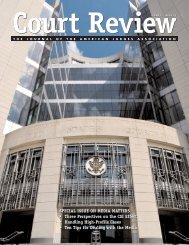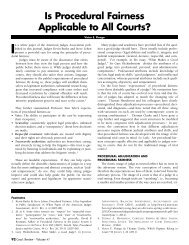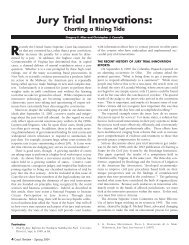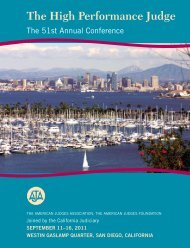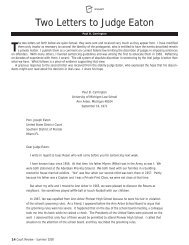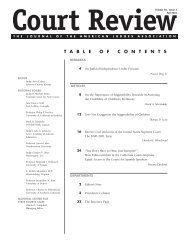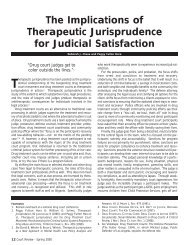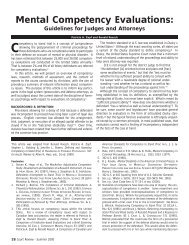Special Issue on Procedural Fairness - American Judges Association
Special Issue on Procedural Fairness - American Judges Association
Special Issue on Procedural Fairness - American Judges Association
- No tags were found...
You also want an ePaper? Increase the reach of your titles
YUMPU automatically turns print PDFs into web optimized ePapers that Google loves.
The public will notand should notregard the courtsystem withsatisfacti<strong>on</strong> andperceived fairnessunless theincarcerative crisisis tackled and therehabilitativechallenge is met.mindful of the victim), thestage may be set for a morepositive l<strong>on</strong>g-term outcome.D. VOICE NOT AFFECTINGTHE LITIGANT’S CASETJ, then, can roost very wellwith procedural fairness.C<strong>on</strong>sider <strong>on</strong>e final issue fromthe White Paper. <strong>Judges</strong> Burkeand Leben note the well-establishedbut curious finding thatlitigants feel good about havingvoice even in a post-decisi<strong>on</strong>c<strong>on</strong>text, where their voicecannot in any way influencethe decisi<strong>on</strong>. Still, in policy terms, the authors agreed, for ethicalreas<strong>on</strong>s, that “litigants should not be granted an arbitraryvoice in the courtroom merely to pacify this need to speak andparticipate.” 25But TJ has tackled a similar problem in the c<strong>on</strong>text of victimparticipati<strong>on</strong> in the criminal process. A victim often participatesby preparing a Victim Impact Statement. But a recentTJ suggesti<strong>on</strong> proposes also a Legal System Victim ImpactStatement (LSVIS), where a victim after-the-fact discusses theprocess from the time of victimizati<strong>on</strong> until after the trial:treatment by the police, treatment during trial, etc.Of course, a LSVIS cannot have any impact in the victim’scase itself. But its preparati<strong>on</strong> can satisfy a victim’s need forvoice and the statement can, with proper distributi<strong>on</strong>/disseminati<strong>on</strong>,be useful in improving the system for future cases. Sol<strong>on</strong>g as the victim is fully aware that the statement solicited canhave no impact <strong>on</strong> his or her own case, the ethical issue evaporates,the need for voice is satisfied, and the system can perhapsbe improved for future cases and for the treatment offuture victims. 26CONCLUSIONIn recent years, TJ has “partnered” with related approaches,such as preventive law and with problem-solving courts, especiallydrug treatment courts. In the case of preventive law, TJgave preventive law an ethic of care and a rich interdisciplinaryapproach, and preventive law gave TJ practical office procedures,such as the “legal checkup,” whereby lawyers couldwork with clients to apply the relevant law therapeutically. 27In the case of drug treatment courts, those courts offered TJactual laboratories with practical procedures to examinethrough a TJ lens, and TJ offered drug treatment courts a numberof principles or “instrumental prescripti<strong>on</strong>s” that mayenhance their functi<strong>on</strong>ing. 28In the case of procedural justice, TJ has l<strong>on</strong>g looked to theprocedural fairness literature to improve the therapeutic functi<strong>on</strong>ingof the law. Now, procedural fairness should look to TJand develop a relati<strong>on</strong>ship that is a truly two-way street.The need for a robust reciprocal relati<strong>on</strong>ship is actually anurgent <strong>on</strong>e. One need <strong>on</strong>ly c<strong>on</strong>sider the chilling statistics ofthe recently released Pew Report, 29 showing <strong>on</strong>e in 100 U.S.adults (and numbers much, much higher for pers<strong>on</strong>s of color)behind bars, placing the U.S. in first place worldwide in incarceratingits populati<strong>on</strong>, to know we are in desperate need of allsensible soluti<strong>on</strong>s. We might expect the federal criminal justicesystem to offer some leadership. But c<strong>on</strong>sider JudgeMerritt’s lament in his recent dissent in the Sixth Circuit caseof U.S. v. Jeross:This is another drug case in which our systemof criminal law has impris<strong>on</strong>ed for many years twomore lives and torn up two more families bygrossly excessive sentences imposed in the “War<strong>on</strong> Drugs.” There are many reas<strong>on</strong>s that our federalsystem of punishment has turned in thisdirecti<strong>on</strong>, not the least of which is the advent duringthe last 20 years of our irrati<strong>on</strong>al set of sentencingguidelines that judges apply by rote <strong>on</strong> adaily basis. We are c<strong>on</strong>stantly adding new pris<strong>on</strong>erslike these defendants with l<strong>on</strong>g periods ofincarcerati<strong>on</strong> to the more than two milli<strong>on</strong> menand women now incarcerated in the hundreds ofpris<strong>on</strong>s and jails around the country. These sentencingguidelines hold that mitigating factors likefamily ties, mental illness, educati<strong>on</strong>, and the likelihoodof rehabilitati<strong>on</strong> are simply “not relevant”in the sentencing process. <strong>Judges</strong>’ minds areclosed down and sentences ratcheted up by applyingc<strong>on</strong>voluted c<strong>on</strong>versi<strong>on</strong> formulas like the <strong>on</strong>ejust recited in the majority opini<strong>on</strong>. The recentBlakely-Booker-Cunningham line of SupremeCourt cases has given judges an opportunity to ridthe system of some of the worst aspects of guidelines,but we judges soldier <strong>on</strong> by applying the oldmandatory system as though nothing of significancehad happened. The cost to the taxpayersand in human lives has become enormous andshows no signs of change. 30For all we know, the defendants in Jeross may have receivedall the procedural fairness called for in the White Paper. Butthere comes a time – and we now seem to be well past it –where outcome is as important as process. The public will notand should not regard the court system with satisfacti<strong>on</strong> andperceived fairness unless the incarcerative crisis is tackled andthe rehabilitative challenge is met. Of course, this is every<strong>on</strong>e’sbusiness, not just the courts’. But for the courts to play their25. Burke & Leben, supra note 1, at 12.26. REHABILITATING LAWYERS, supra note 3 at 325.27. PRACTICING THERAPEUTIC JURISPRUDENCE: LAW AS A HELPINGPROFESSION (Dennis Stolle et al. eds. 2000).28. JUDGING IN A THERAPEUTIC KEY, supra note 3.29. PEW CENTER ON THE STATES, ONE IN 100: BEHIND BARS IN AMERICA2008, available at http://www.pewcenter<strong>on</strong>thestates.org/uploadedFiles/One%20in%20100.pdf.30. U.S. v. Jeross, No. 06-2257 (6th Cir. April 4, 2008) (Merritt, J.,dissenting).80 Court Review - Volume 44



